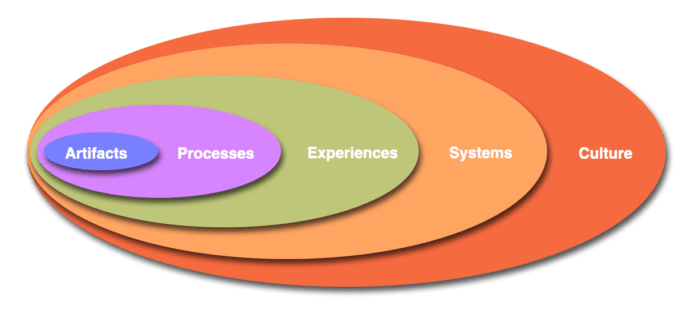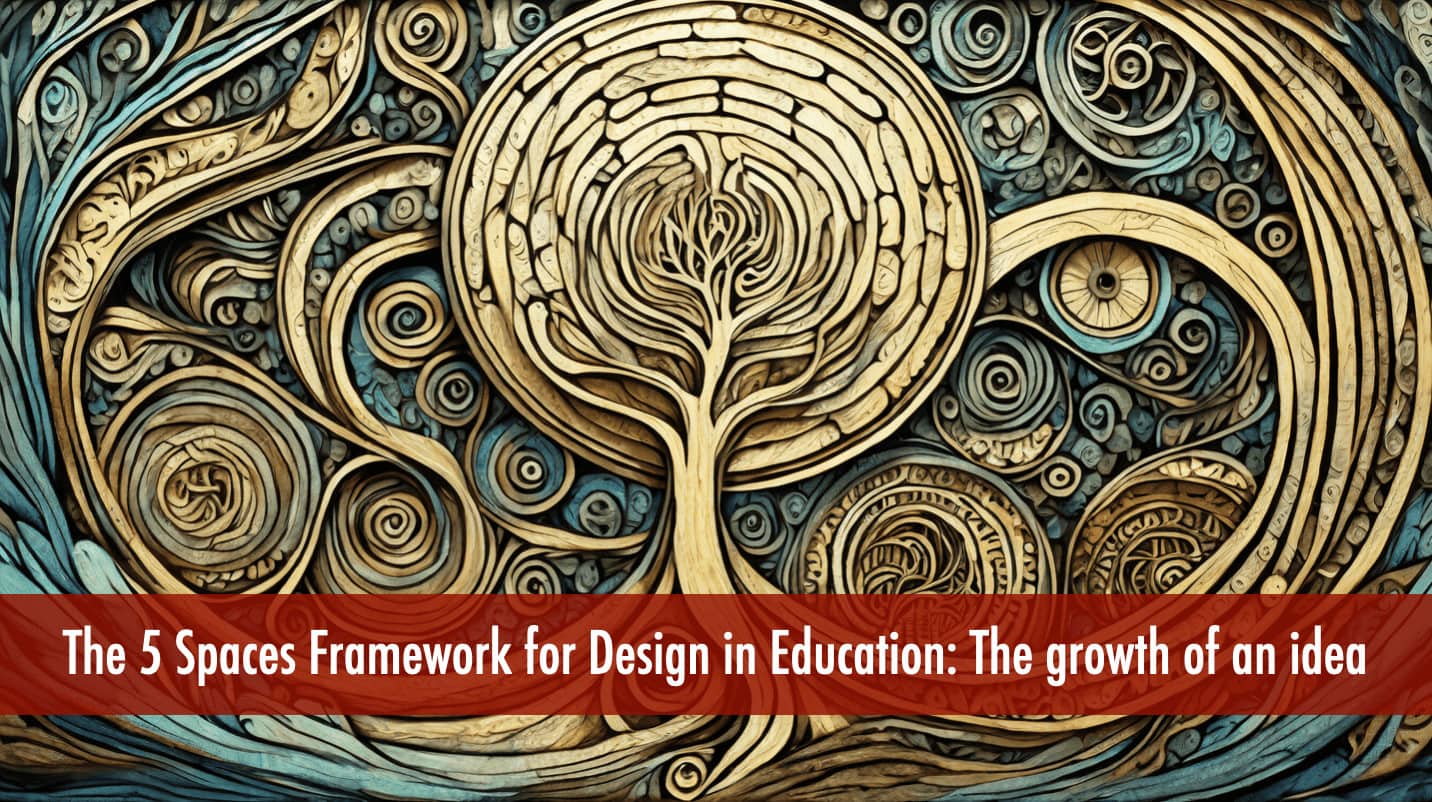The Five Spaces for Design in Education framework argues that design in education happens in 5 interrelated spaces: artifacts, processes, experiences, systems and culture. We have typically represented this as follows.

Over the past years we have published and presented these ideas in multiple outlets and conferences. This page is an ongoing archive of our work in this area, with links to articles and slides when possible.
- Warr, M., Close, K., & Mishra, P. (2023). What Is Is Not What Has to be: The Five Spaces Framework as a Lens for (Re)design in Education. in B. Hokanson, M, Schmidt, M. E. Exter, A. A. Tawfik, & Y Earnshaw (Eds.) Formative Design in Learning: Design Thinking, Growth Mindset and Community. Educational Communications and Technology: Issues and Innovations. Springer. https://doi.org/10.1007/978-3-031-41950-8_24
- Abstract: Design is everywhere. Recognizing how everything in education is designed, including systems and cultures, increases our agency to make changes on those designs. In this chapter, we introduce the five spaces framework which pro- vides an analytical tool for understanding the relationships among designed entities, shifting perspectives and offering new possibilities for (re)design. To illustrate the framework, we analyze three technologies in education: the teacher’s desk, PISA test, and learning management systems.
- Close, K., Warr, M., & Mishra, P. (2023). The Ethical Consequences, Contestations, and Possibilities of Designs in Educational Systems. TechTrends. https://doi.org/10.1007/s11528-023-00900-7
- Abstract: Emerging technologies present new possibilities for schools, but also present ethical issues for designers. Ethical issues arising from the design, accessibility, adoption, and implementation of emerging technologies in schools are intertwined with existing power dynamics, hierarchies, and decision-making norms that perpetuate entrenched systems. Using a framework called the fives spaces for design in education framework as an analytical lens, we explore the ethical implications of two emerging artificial intelligence technologies in education: remote proctoring software and large language models. We find that designers adopting and implementing these emerging technologies must attend to the consequences of past design decisions and recognize that emerging technologies also create places for resistance and contestations. Lastly, by recognizing the wide scope of what can be redesigned, designers can start to see possibilities for redesigning in ways that are inclusive, equitable, and ethically conscious. Ultimately, we hope to begin a critical conversation about the two technologies by thinking about the sites of consequence, contestation, and possibilities in the designed cultures, systems, experiences, processes, and artifacts of schooling.
- Warr, M., Mishra, P., Scragg, B., Powers, J., & Wong, L-S. (2022). Complicating Design Thinking in Education: A University-School District Partnership to Design and School for the Future. In Sanzo, K. L. & Scribner, J. P. (Eds.), Design Thinking: Research, Innovation, and Implementation. Information Age Publishing.
- Abstract: In this chapter, we apply two types of design models (process and domain) in an analysis of a university-school district design partnership. Design thinking process models outline how to design, while design domain models illustrate what is designed and the interactions of multiple types of designs. A design team from the university led monthly sessions with a group of stakeholders from the school district to design a new school model. Although the design team attempted to follow a design thinking process, the models describing design thinking failed to reflect the complexities of what occurred. We outline four complexities of the design partnership: finding the problem is the biggest problem, ideation is not just for finding potential solutions, design does not occur in a vacuum, and designing systems cannot be done piecemeal. We consider each from the lens of design process models and design domain models. Using the two lenses together enriched our understanding of the nuances and complexities of multi- stakeholder design in education.
- Mishra, P., Warr, M., & Scragg, B. (2022). Two possible futures of online learning. In S. P. McKenzie, L. Arulkadacham, J. Chung and Z. Aziz. (Eds). The future of online education: Advancements in learning and instruction. Nova.
- Abstract: During the COVID-19 pandemic in 2020, online learning became mainstream, enabling schools to continue operation even with students and teachers physically separated. In this chapter, we extend the trends we observed in pandemic online learning to describe two possible futures for online learning, one dystopian and one utopian. We argue that what differentiates these futures is less about the technological tools used and more about the broader processes, systems, and culture embedded with online learning. We call for deliberate reflection on the dynamic relationship among technological tools, processes, experiences, systems, and culture as we shape the future of online learning.
- Warr, M., & Mishra, P. (2022). Contextualizing TPACK in systems and Culture. Society for Information Technology & Teacher Education International Conference.
- Mishra, P., Warr, M. (2021). Contextualizing TPACK within systems and culture. Computers in Human Behavior. 117. https://doi.org/10.1016/j.chb.2020.106673
- Warr, M., & Close, K. (2020). Designing culture for learning. 2020 AECT International Convention. 2020 AECT International Convention.
- Weiner, S., Warr, M., & Mishra, P. (2020). Fostering System-Level Perspective Taking when Designing for Change in Educational Systems. TechTrends. https://doi.org/10.1007/s11528-020-00529-w
- Abstract: A core element of systems thinking is perspective taking. Perspectives help people distinguish between salient and irrelevant information, take particular types of actions, and make sense of the world. In this article, we consider what systems thinking and perspective taking means for designers in education. First, we present a framework, the five spaces for design in education, to illustrate design work in education. The framework presents five spaces for design: artifacts, processes, experiences, systems, and culture. We claim that most—if not all—educators participate in design work; however, the design spaces they work in vary. Consequently, educational designers often fail to consider the perspectives of those working in different spaces, resulting in failed reform efforts. We illustrate this concept through the technology integration attempts of the Los Angeles Unified School District. We argue more effective design in education occurs when designers both recognize their own design perspective and are aware of other perspectives.
- Mishra, P., & Warr, M. (2020). Foreword: A Systems View of Technology Infusion. In A. C. Borthwick, T. S. Foulger, & T. S. Graziano, (Eds). Championing technology infusion in teacher preparation: A framework for supporting future educators. International Society for Technology in Education. (p. xvi-xxii).
- Warr, M., Mishra, P., & Scragg, B., (2020). Designing Theory. Educational Technology Research and Development. https://doi.org/10.1007/s11423-020-09746-9
- Abstract: Theoretical work is essential to the progress of any discipline. Theories, models, and frameworks are underdetermined representations of a phenomenon that help us understand and take action in a domain. However, the field of learning design and technology (LDT) has traditionally struggled with developing a solid theoretical foundation that is useful for both research and practice. We propose viewing theory building as an act of design might address these challenges. After defining key constructs and describing two approaches to theory development, we describe three design perspectives that might be useful for theory development: Lawson and Dorst’s (Design expertise, Elsevier, Amsterdam, 2009) view of design as a combination of analytical (problem-based) and creative (solution-based) moves, Schön’s (The reflective practitioner: how professionals think in action, Basic Books, New York, 1983) reflection-in-action, and design as dialogic interpretation (Snodgrass and Coyne in Des Issues 9(1):56–74, https ://doi.org/10.2307/15115 99, 1992). We use a case study to illustrate each perspective. We conclude with implications of a design approach to theory creation, including how design perspectives enable scholars to design possible futures.
- Warr, M., Mishra, P., & Scragg, B. (2019). The five discourses of design: A model for systemic change in education. Association for Educational Communications and Technology National Conference, Las Vegas, NV
- Warr, M., Mishra, P., & Scragg, B. (2019). Beyond TPACK: Expanding technology and teacher education to systems and culture. Society for Information Technology & Teacher Education International Conference, 2233–2237. https://www.learntechlib.org/primary/p/208009/
- Mishra, P., Scragg, B., & Warr, M. (2018). The 5 Discourses of Design in e-Learning. Paper presented at eLearn 2018, Las Vegas. [Link to slides]
- Warr, M., Henriksen, D., & Mishra, P. (2018). What do we mean when we “design” e-learning solutions? An analysis of the discourses on education and design. Paper presented at eLearn 2018, Las Vegas. [Link to slides]



0 Comments